

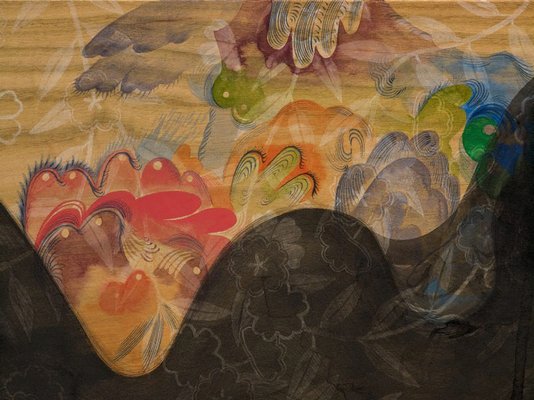
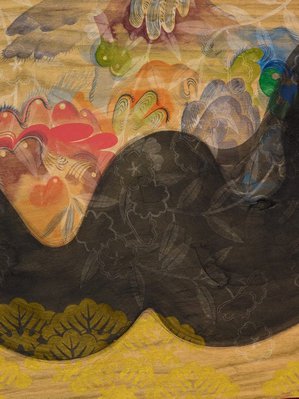

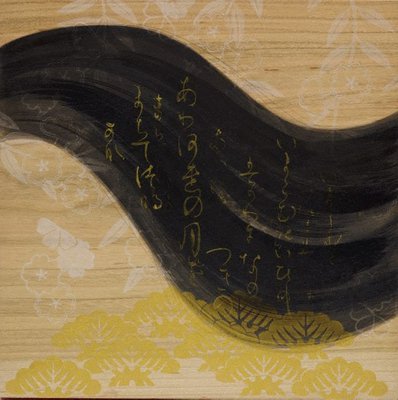
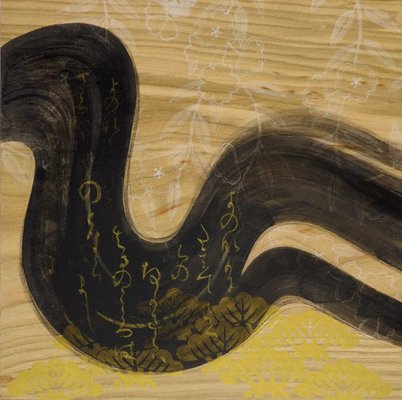
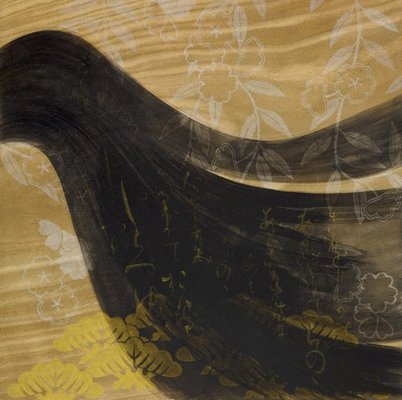

-
Details
- Place where the work was made
-
Japan
- Date
- 2012
- Media categories
- Painting , Installation
- Materials used
- acrylic paint and gold paint on wild cherry wood
- Dimensions
-
a - panel, 30 x 30 x 2 cm
b - panel, 30 x 90 x 2 cm
c - panel, 30 x 30 x 2 cm
d - panel, 30 x 90 x 2 cm
e - panel, 30 x 30 x 2 cm
f - panel, 30 x 90 x 2 cm
g - panel, 30 x 30 x 2 cm
h - panel, 30 x 90 x 2 cm
i - panel, 30 x 30 x 2 cm
j - panel, 30 x 90 x 2 cm
k - panel, 30 x 90 x 2 cm
l - panel, 30 x 30 x 2 cm
m - panel, 30 x 90 x 2 cm
n - panel, 30 x 30 x 2 cm
- Credit
- Purchased with funds provided by the Art Gallery Society of NSW 2012
- Location
- Not on display
- Accession number
- 257.2012.a-n
- Copyright
- © ai yamaguchi・ninyu works
- Artist information
-
Ai Yamaguchi
Works in the collection
- Share
-
-
About
In this mural work Yamaguchi furthers her exploration of the decorative potential of the meandering streams of hair that figure prominently in her installation 'We have as much to talk about as this mountain is tall'. The sinuous silhouette of the long jet-black and shiny tresses references the stylised rivulets often encountered in Rinpa painting. Yamaguchi, however, disrupts the flow, misaligning several sections to evoke a sense of disorder. Reflecting upon the sense of liberation felt when the top-knot of a hairstyle, which traditionally defined the social and marital status of a woman in pre-modern Japan, is dissolved and the moment of chaos that exists between the deconstruction and reconstruction of the hairdo, Yamaguchi draws parallels with her own work as an artist. For her, the process in the creation of a painting initially stems from letting imagination and fantasy run free; it then proceeds to the discovery of a logic among the disorder of thoughts and finally it becomes a transformation of the chaos into a coherent work.
Ai Yamaguchi graduated from the Department of Crafts, Women’s College of Fine Arts, Kanagawa ('Joshi Bijutsu Daigaku') in 1998; her area of specialisation was weaving. She was a founding member of ‘ninyu works’, a collective of artists and curators established in 1999. Yamaguchi received recognition in Japan and internationally following her collaboration with world-renowned Japanese make-up artist Shu Uemura (1928–2007), who commissioned her to design the packaging for his cosmetics range in 2004.
Artist’s statement:
'Hanahiru" means "sneeze". A sneeze is often perceived as a prediction for some unexpected event or rumour affecting ourselves. I believe countless fragments of such signs are spilled in the flow of black hairs. I painted this work starting with the idea that the beauty I truly look for lies here in the numerous thoughts lurking inside the artworks I have created in my career.Hair is a part of ourselves as well as something that seems to have a separate existence, joining the inside with the outside, giving the impression to link our bodies with their surroundings. It feels like from the scalp to the point of each hair run one's passage of time, their thoughts and instincts, like annual growth rings. For example, when someone touches someone else's hair, both have sharps sensations, where many stories are hidden.
I have the impression that to smell a fragrance you used to appreciate on your hair stimulates a sixth sense enabling you to immediately be aware of yourself, and also that black hair has a visual appeal that feels like a depth ready to absorb your gaze. Then I painted the endless thoughts unfolding in this black hair, as well as calligraphy. Calligraphy, like painting, requires the use of a brush and can be considered as the ancestor of painting, so that is why I studied it a little. From calligraphy to painting and vice-versa, I believe their must be such come and go in the space of black hair. Thoughts are reflected on the black hair which becomes brush and ink and are given form, waving freely.
The floral motif in the background behind the fair is a kimono pattern that I myself adapted. I shaped the pine pattern so that it looks like a mountain. I thought that the flow of black hair would make the weeping cherry tree painted over it look like one landscape between two mountains. The pattern can be rearranged in many ways and each complete unit can be multiplied even despite its intrinsic rules, giving the possibility to freely go on creating shapes that no one ever imagined.'
The poems are from the collection of the 36 immortal poets. From the right the poems read as follows:
The warm light of spring
floods the country all around -
the land is bright;
but far on fair Yoshino's mountains
the snow still is coming downŌshikōchi Mitsune, d.925
-----------------
Faintly with the dawn
that glimmers on Akashi Bay
in the morning mist.
A boat goes hidden by the isle –
and my thoughts go after it.Kakinomoto Hitomaro, c.662–710
-----------------
Just because she said
‘In a moment I will come’,
I've awaited her
until the moon of daybreak,
in the long month, has appeared.Sosei Hôshi, c.844–910
-----------------
If, in this world of ours
all the cherry blossom
disappeared,
the heart of spring
might find peace.Ariwara Narihira, 825–-80
-----------------
A parent's
heart in darkness
may not be, yet
fondly thinking on his child,
his way has he lost, indeed...Fujiwara Kanesuke, 877–933
-----------------
Almost they seem pearls -
the white dewdrops glistening
on autumn bush clover
in fields where of a morning
the fair stag comes to standŌtomo Yakamochi, c.716-85
-----------------
I have met my love.
When I compare this present
with feelings of the past,
my passion is now as if
I have never loved before.Fujiwara Atsutada, 906–-43
-----------------Asian Art Department, AGNSW, August 2012.
-
Places
Where the work was made
Japan
-
Exhibition history
Shown in 2 exhibitions
Kamisaka Sekka - Dawn of modern Japanese design, Art Gallery of New South Wales, Sydney, 21 Jun 2012–26 Aug 2012
Conversations through the Asian collections, Art Gallery of New South Wales, Sydney, 25 Oct 2014–13 Mar 2016
